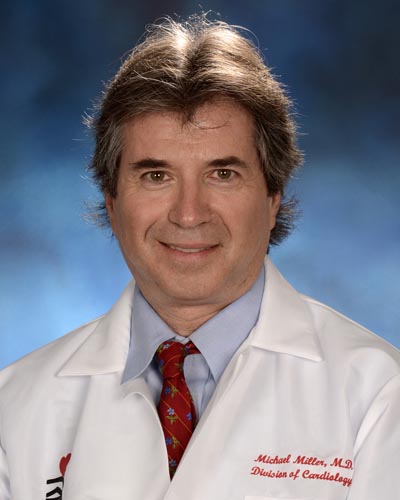New Clues to Reducing Risk of Heart Disease
Researchers at the University of Maryland School of Medicine (UMSOM) have uncovered genetic mutations that may explain why people with high levels of high-density lipoprotein (HDL) cholesterol, the “good cholesterol,” have a reduced risk of coronary heart disease.
High HDL levels are associated with longevity in families, suggesting the possibility of a genetic connection. HDL also has antioxidant and anti-inflammatory properties that may contribute to heart protection.
To home in on the genetic connection, the researchers examined large-scale heart disease databases and focused on patients who had been screened with an extensive genetic test.

Michael Miller, MD, professor of cardiovascular medicine, epidemiology, and public health at the University of Maryland School of Medicine and director of the Center for Preventive Cardiology, University of Maryland Medical Center.
The researchers say their findings, published in the Journal of Clinical Lipidology, could open the door to new ways to reduce cardiovascular risk.
“We tried to identify novel genes associated with very high HDL, found about a hundred genes that could have fit the pattern, then eliminated most of them because they were also found in people with low HDL,” says the study’s senior author, Michael Miller, MD, professor of cardiovascular medicine, epidemiology, and public health at UMSOM and director of the Center for Preventive Cardiology, University of Maryland Medical Center. “Ultimately, we found eight genes that may somehow protect the heart, even though seven of them have not been specifically linked to HDL metabolism.”
HDL levels are expressed in milligrams per deciliter (mg/dL) of blood. The typical number is 45 for men, 55 for women. This study looked at people with HDL levels of 80 mg/dL or higher, including well over 100. Extremely high HDL is known as hyperalphalipoproteinemia (HALP).
In some cases, the cardioprotective effect associated with HALP was unexpected. “We were surprised to find that some of the high HDL patients who were smokers, had high blood pressure, and were older, in their 70s or 80s, had not experienced a coronary event such as a heart attack,” Miller says.
The researchers drew from six sources where a genetic screening technique called whole exome sequencing (WES) was used to identify genetic variations. The sources included the University of Maryland Preventive Cardiology clinic, Cardiovascular Health Study (CHS), Jackson Heart Study (JHS), Multi-Ethnic Study of Atherosclerosis (MESA), Framingham Heart Study (FHS), and the Old Order Amish population of Lancaster, Pa. Of 1,645 subjects, researchers identified 72 with very high HDL.
Miller says there are challenges in working with HDL. “Think of HDL as a cargo ship that not only transports cholesterol for disposal (its most well-known function) but also contains at least 80 different proteins. The relationship between HDL and many of these proteins is not well understood,” he says.
“This study is an important first step toward understanding whether there is anything more to these genes,” says E. Albert Reece, MD, PhD, MBA, executive vice president for medical affairs at the University of Maryland, the John Z. and Akiko K. Bowers Distinguished Professor, and dean of UMSOM. “For example, these genes may affect lipid metabolism in ways that have not been understood previously. A related question is whether an effect on lipid metabolism also implies changes in the risk of heart disease.”
The study was supported by grants from the National Institutes of Health.



